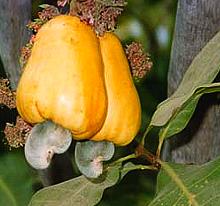
SAFARI
Users
Cashews
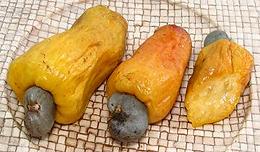 [Marañon (Spanish); Caju (Brazil); Anacardium occidentale]
[Marañon (Spanish); Caju (Brazil); Anacardium occidentale]
The Cashew is native to Brazil which is still a major grower, though long overshadowed by India which has itself been eclipsed by Vietnam. Looking at the photo at the top of the page you can see the true fruit, shaped like a cashew nut, with a false fruit, the "cashew apple" above it.
Cashews are never shipped "in the shell" because the "shell" is laced with blistering levels of the irritant urushiol. Cashews must be shelled and prepared with great care to prevent toxicity and injury to workers. While rare, there have been cases of mass rash breakouts from cans of nuts contaminated with pieces of shell.
The "cashew apple" is edible but used fresh only locally because it is
highly perishable, starting to ferment within 24 hours. It is used mainly
to make jams and fermented and distilled into alcoholic beverages. There
is also an Australian cashew, Semecarpus australiensis with a
similar structure and requiring similar care in handling, but it has
a very small apple and lacks the "cashew curve".
Details and Cooking.
Mangos
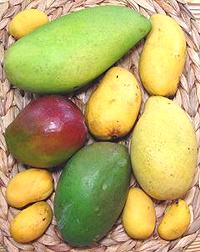 [A. Mangifera indica | Mangifera sylvatica]
[A. Mangifera indica | Mangifera sylvatica]
Native to India and Southeast Asia mangos have been cultivated since prehistory. Over 1000 varieties are recognized and hundreds are cultivated in India where the fruit is a national obsession. We see just a few varieties here in California. Mangos ripen from June to November depending on variety and where they are grown, earlier inland later on the coast.
India is by far the largest grower of mangos followed by Southeast Asia, but most sold in the U.S. are grown in Mexico. Florida production was largely wiped out by hurricane Andrew (1992) and has not been restored due to doubts Florida could be price competitive (and fear of more hurricanes). Significant production began around 2002 in Southern California, but production can not yet meet demand (2013), even at a premium price.
While all mangoes sold in North America are M. indica, the
Pickling Mango M. sylvatica also figures in India and Southeast
Asia. All the other species are too toxic to be exploited. We now have
a separate page for Mangos, including
Mango Varieties - Details & Photos.
Spondias
[Genus Spondias]
- Spondia fruits are often gathered from the wild in their native regions, but a few are in fairly intense cultivation, particularly June Plums and Jocotes. Listed here are the most important.
June Plum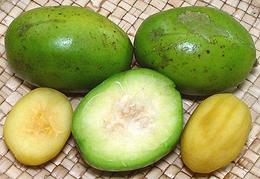 [Ambarella, Tahitian Apple, Otaheite Apple, Golden Apple; Vi (Hawaii,
Tonga); Makok farang (Thai); Cay coc (Viet); Kedondong, Ambar
(Indonesia, Malaysia); June Plum, Pomme cythere Manzana de oro
(Caribbean); Ambarella (Sri Lanka, Dutch); Juplon (Costa Rica);
Jobo indio (Venezuela), caja-manga, cajarana (Brazil);
Spondias dulcis syn Spondias Cytherea]
[Ambarella, Tahitian Apple, Otaheite Apple, Golden Apple; Vi (Hawaii,
Tonga); Makok farang (Thai); Cay coc (Viet); Kedondong, Ambar
(Indonesia, Malaysia); June Plum, Pomme cythere Manzana de oro
(Caribbean); Ambarella (Sri Lanka, Dutch); Juplon (Costa Rica);
Jobo indio (Venezuela), caja-manga, cajarana (Brazil);
Spondias dulcis syn Spondias Cytherea]
Native to Melanesia and Polynesia, this fruit is now heavily planted
in the Caribbean and Southeast Asia. The flesh is crisp and slightly
tart, surrounding a fibrous seed. Due to the seed, they cannot be
easily sliced or pitted, so are often eaten out of hand. In Indonesia
and Malaysia they would be accompanied by a little shrimp paste. They
are also pickled, cooked for preserves, juiced, and used in sauces,
soups and stews.
Details and Cooking.
Hog Plum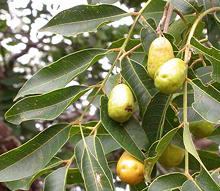 [Makok (Thai); Yellow Mombin, Hog Plum (Caribbean); Jobo Criollo
(Dominica); Spanish Plum, Gully Plum (Jamaica); Ashanti Plum (Ghana);
Amra (Bangladesh); Golden Apple, Java Plum; Spondias mombin]
[Makok (Thai); Yellow Mombin, Hog Plum (Caribbean); Jobo Criollo
(Dominica); Spanish Plum, Gully Plum (Jamaica); Ashanti Plum (Ghana);
Amra (Bangladesh); Golden Apple, Java Plum; Spondias mombin]
This tree is native to the tropical Americas, but now found in the
tropics worldwide. It seldom cultivated but picked wild. The fruit
flesh is eaten fresh or used for juice and jelly. In Thailand young
leaves (Bai Makok), which have a slightly sour-bitter taste, are eaten
raw with nam phrik, a chili condiment variously made. The
fruits are used in green papaya salads in Thailand and Laos.
Photo by Marco Schmidt distributed under Creative Commons
Attribution-ShareAlike v2.5. Jocote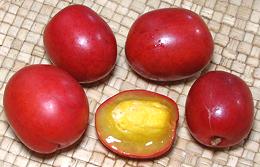 [Ciruela Roja, Ciruela Huesito, Red Mombin, Purple Mombin, Sineguela,
Siriguela; Spondias purpurea]
[Ciruela Roja, Ciruela Huesito, Red Mombin, Purple Mombin, Sineguela,
Siriguela; Spondias purpurea]
This small to medium size tree is native to the tropical Americas, and now cultivated in the tropics worldwide for its fruits. Cultivars are being selected for fruit quality and yield to improve the crop. The fruit is like a tiny, round mango, sweet when ripe, very tart when not yet ripe. Unlike the mango, the skin is often eaten with the fruit. While they are most commonly eaten ripe, either fresh or
simmered in a syrup, they are also eaten not quite ripe with salt
and lime juice. The photo specimens, previously frozen, were about
1.6 inches long and 1.4 inches diameter, the largest weighing about
1 ounce. They were purchased from a large multi-ethnic market in
Los Angeles, 2012 US $2.85 / pound, bagged in the freezer section.
Umbu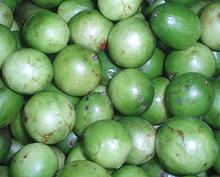 [Brazil plum; Imbu (Portuguese); Spondias tuberosa]
[Brazil plum; Imbu (Portuguese); Spondias tuberosa]
Native to Bahia state in northeastern Brazil, this is an important
fruit in dry regions because of its high yield and drought resistance.
The spherical fruit, which can range from 1 inch to 2 inches diameter,
may be light green to light yellow when ripe. The flesh is soft,
juicy and sweet, often mixed with other fruits and and used in fruit
juices, jams and sorbets. It has to be harvested by hand because it
is quite delicate.
Photo by Daniele Gidsicki distributed under Creative
Commons
Attribution v2.0 Generic.
|
Pepper Trees
[Genus Schinus]
These trees are in no way related to the plants that give us black, white, green, red or Sichuan peppercorns. They provide instead the Pink Peppercorns that were so popular with the fancy chef set some years back. There has been much talk of pink peppercorns grown in Florida causing throat irritation, but in general there is almost no irritant in dried berries.
Brazilian Pepper Tree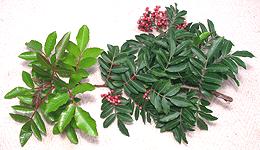 [Florida Holly, Christmasberry, Schinus terebinthifolius]
[Florida Holly, Christmasberry, Schinus terebinthifolius]
Fruits of this tree are used in the Caribbean for both seasoning and medicinal purposes. "Pink peppercorns" from trees growing in Florida were reputed to cause an allergic reaction in some people (throat irritation) so the chefs get their berries from the Caribbean island of Réunion. Whether this is a real problem or just a move to protect a cash crop on Réunion I do not know, but I've had no problem with the ones from my trees here in California. This low growing tree is extremely invasive in wet climates and almost
impossible to eradicate, particularly a problem in Hawaii and Florida.
It can be told from the California / Peruvian pepper tree by the rounded
tips of its leaves and it's low, dense, even sprawling growth habit. Note
in the photo new spring growth with the berries on the previous year's
growth. Details and Cooking.
California / Peruvian Pepper Tree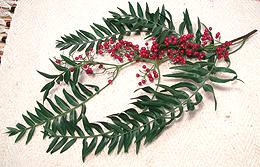
[Peruvian Mastic tree, Schinus molle]
This tree is very common in Southern California and is easy to tell from
the Brazilian Pepper Tree. It grows as a large tree with drooping branches
bearing very long leaves with many narrow sharply pointed leaflets. The
Inca used the berries to make fermented beverages and flavoring syrups.
The tree is also used as a medicinal, but is toxic to some animals and
possibly small children. I get these leaves and berries from the Bank
of America parking lot down on the corner, but find the berries of my
Brazilian pepper trees to be much sweeter and milder. This tree is
drought resistant and is a serious invasive in South Africa and Australia.
Details and Cooking.
|
Pistacia
[Genus Pistacia]
This genus is native to warmer parts of Eurasia, North America and all of Africa.
Pistachio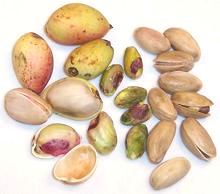 [Pistacia vera]
[Pistacia vera]
Pistachios used to come from Iran, Afghanistan and Turkey. Today I see some Turkish in markets serving Mid Eastern communities, but Iranian aren't much available due to embargos. Afghanistan seems to have found opium more profitable. California has taken up the slack. After testing 13 varieties, Kerman and Lassen were chosen for nut bearing female trees and Peters as a male pollen producer. Kerman and Lassen produce particularly large crisp nuts. The first harvest was in 1976 and California is now the second largest producer in the world at 400 million pounds. Some have been saying Iranian nuts are better, but we can't know as Trump has renewed conflict with Iran. Iran does grow more varieties (C1). The Turkish I've found are good but often over-roasted. The photo specimens are all Californian. To the right are roasted nuts, in the center roasted kernels, and to the left are fresh whole fruits and unroasted nuts (probably not much available in North America outside California).
Mastic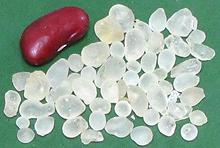 [Chios Tears; Pistacia lentiscus]
[Chios Tears; Pistacia lentiscus]
This small tree is the source of Mastic Resin, used widely in
Greece, Turkey, the Levant and Egypt as a spice, chewing gum and
medicinal. Production is very labor intensive, so mastic resin is
quite expensive. Nearly all is produced on the Greek island of Chios,
where production has been somewhat reduced by a forest fire in 2012.
Some has always been produced on the Turkish peninsula of
Çeçme, just a few miles from Chios, and production
there is being ramped up. It is used in sweets, baked goods, ice cream,
fruit and vegetable preserves, soups and savory dishes.
Details and Cooking.
Terebinth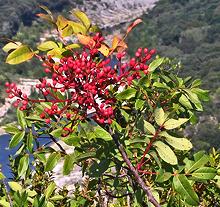 [Turpentine Tree; Cornicabra (Spanish); Pistacia terebinthus
| also Pistacia palaestina]
[Turpentine Tree; Cornicabra (Spanish); Pistacia terebinthus
| also Pistacia palaestina]
This small tree is native to Iran, and around most of the
Mediterranean, but largely replaced by very similar P.
palaestina in the Levant. It was the original source of
turpentine, distilled from the sap. Resins from these trees were used
as a preservative in wine more than 7000 years ago. in Crete the fruits
are used in a special village bread, and young shoots are eaten as
vegetables in a few Greek locations.
Photo by MPF distributed under license Creative Commons
Attribution-ShareAlike v3.0 Unported.
|
Sumac
[Genus Rhus]
There are many varieties of Sumac worldwide, some of which may contain sufficient amounts of the irritant urushiol to be unpleasant, even more unpleasant than poison ivy. The fruits of some are usable but reliable local knowledge is recommended. The dangerously toxic species have now been separated out as a separate genus, Toxicodendron.
Sumac Spice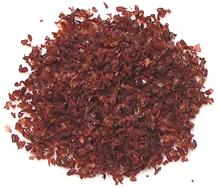 [Rhus coriaria]
[Rhus coriaria]
Fruits of this Near Eastern species are used to make a dry
purple-red souring agent used in place of lemon. It is widely used and
sold in the U.S. simply as "Sumac". It is a very important ingredient
in the region, so you can easily find it in markets serving Levantine
and Middle Eastern communities. Do not attempt to use common North
American sumac berries for this, as they will have various levels of
toxicity.
Details and Cooking.
Staghorn Sumac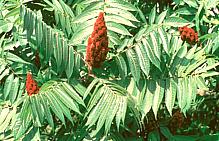 [Rhus typhina]
[Rhus typhina]
The fruits of Staghorn Sumac are soaked strained and sweetened to make
a beverage similar to pink lemonade. The leaves were mixed with
tobacco and smoked by Native Americans and some still use it that way.
Photo U.S. Federal government = public domain.
Lemonade Berry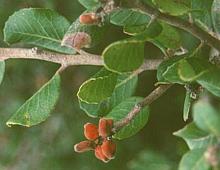 [Rhus integrifolia]
[Rhus integrifolia]
This species grows only in dry costal regions of Southern and Baja
California. The name implies a drink similar to lemonade can be made
from mature berries but I'm not sure what precautions (if any) should
be taken. The seeds can be ground to extract an oil which solidifies
at room temperature and can be used to make candles. This plant really
doesn't look much like a sumac due to its solitary leaves.
Photo distributed under license Creative Commons
Attribution-ShareAlike v2.5.
|
Toxicodendrons
[Genus Toxicodendron]
These highly toxic plants were formerly in Ruhs, the Sumac genus, but have been separated out. They contain significant amounts of the strong contact irritant urushiol. We do not recommend attempting to use any Toxicodendron species for food in any way. This recommendation is self enforcing.
Poison Ivy | Poison Oak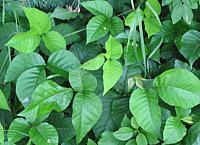
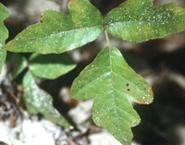 [Toxicodendron radicans | Toxicodendron
diversilobum (Western Poison Oak |
Toxicodendron pubescens (Atlantic Poison Oak)]
[Toxicodendron radicans | Toxicodendron
diversilobum (Western Poison Oak |
Toxicodendron pubescens (Atlantic Poison Oak)]
Low growing plants with leaves in sets of three, but Poison Ivy can
also be a substantial tree climbing vine, easily recognizable by the
dense hairs holding it to the tree trunk. They are common in forested
areas of North America, and contain significant amounts of the strong
contact irritant urushiol. Poison Ivy photo by Esculapio
contributed to the public domain. Photo of Poison Oak by US Federal
Government = public domain.
Poison Sumac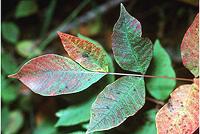 [Toxicodendron vemix]
[Toxicodendron vemix]
Shrubs and small trees up to 30 feet tall, native to very wet or
swampy soils in eastern North America. Very little is west of the
Mississippi or north of the Canadian border. They contain very
significant amounts of the strong contact irritant urushiol, and are
considered by some botanists to be the most toxic plants native to
North America. Photo of Poison Sumac by US
Department of Agriculture = public domain.
|
Malosma
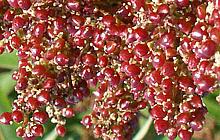 [Laurel Sumac, Malosma laurina]
[Laurel Sumac, Malosma laurina]
A large shrub common among the coastal chaparral of Southern and Baja
California. It got the name Laurel Sumac from having leaves similar
in shape to the unrelated California Laurel. It is currently used only
as a decorative but the Chumash Indians once used the fruits to make
a kind of flour and the bark to make a tea used to treat dysentery.
Photo distributed under license Creative Commons
Attribution ShareAlike 2.0.
Dragon Plum
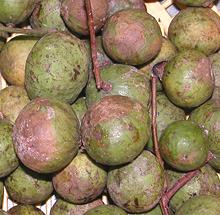 [Chi Sau (Viet); Dracontomelon duperreanum, and several
other species]
[Chi Sau (Viet); Dracontomelon duperreanum, and several
other species]
Dracontomelons are very large trees, native to Vietnam, Cambodia,
parts of southern China, Indonesia, Thailand, the Philippines and
the Pacific Islands. While D. duperreanum is the most eaten, I
haven't been able to find any comment on the taste of even that
one. Lots about the cultural importance of the trees, nothing
about the fruit. Well, they aren't available here in North America,
so I guess that's not going to hurt us much. Photo by
Nguyen Thanh Quang distributed under license Creative Commons
Attribution-ShareAlike v3.0 Unported.
Kaffir Plum
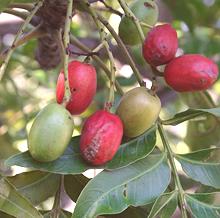 [Harpepbyllum caffrum]
[Harpepbyllum caffrum]
Native to South Africa, this plant has been established in California
as a landscape accent. Small oval bright red fruit are tart and can be
used to make fruit jelly.
Photo by Rotational contributed to the public domain.
Marula
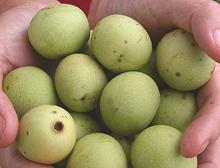 [Morula, Maroola, Jelly plum, cider tree; Harpepbyllum caffrum]
[Morula, Maroola, Jelly plum, cider tree; Harpepbyllum caffrum]
Native to Southern Africa, West Africa and Madagascar, this plant has
been spread by the Bantu, to whom it has always been an important
food. It ripens to a light yellow, with white flesh that contains
8 times as much vitamin C as an orange. It is tart and juicy, with
a strong distinctive flavor. Each fruit contains a hard, roughly
cylindrical stone, which eventually opens and spills seeds that have
a delicate nutty flavor.
Photo by Rotational contributed to the public domain.
Charoli
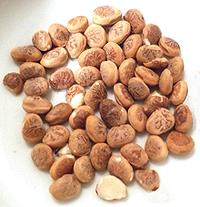 [Chirauli-nut, Chironji, Chiraunji; Buchanania lanzan |
B. latifolia]
[Chirauli-nut, Chironji, Chiraunji; Buchanania lanzan |
B. latifolia]
B. lanza is native to India and Malaysia, while
B. latifolia has a wider range, extending into China and Laos.
Seeds of this shrub look much like pine nuts, and have a similar hard
shell. Once broken out of their shells they have about the same size
and soft consistency as pine nuts, but a flavor compared to almonds
or hazelnuts. They are generally lightly toasted before use, which
is often in sweets. They are also ground for use as a spice, flavoring
and thickener in savory sauces, curries and kormas.
Details and Cooking.
Photo by
Badagnani (cropped, edited, color balanced) distributed under
license Creative Commons
Attribution-ShareAlike v3.0 Unported attribution required.
Safou
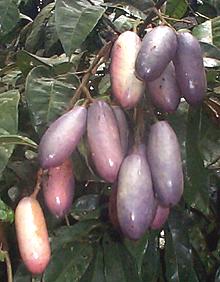 [Bush butter tree, Native pear; Dacryodes edulis]
[Bush butter tree, Native pear; Dacryodes edulis]
This little known fruit tree, native through the wet parts of tropical
Africa, is considered to have great potential for nutrition. It
contains about 63% of oils, including palmitic, oleic, stearic,
linolenic and linoleic fatty acids. It is also high in amino acids,
triglycerides and vitamins. The flesh, which contains about 48% oil
(the rest is in the seeds) may be eaten raw or cooked. Cooked it
has a mouth feel similar to butter. The tree also produces excellent
wood and has medicinal uses. Some of these trees are now being grown
in Malaysia. Photo by uncertain, contributed to
the public domain.
Links
- C1: - Iranian Pistachios - Dorchin Co.
